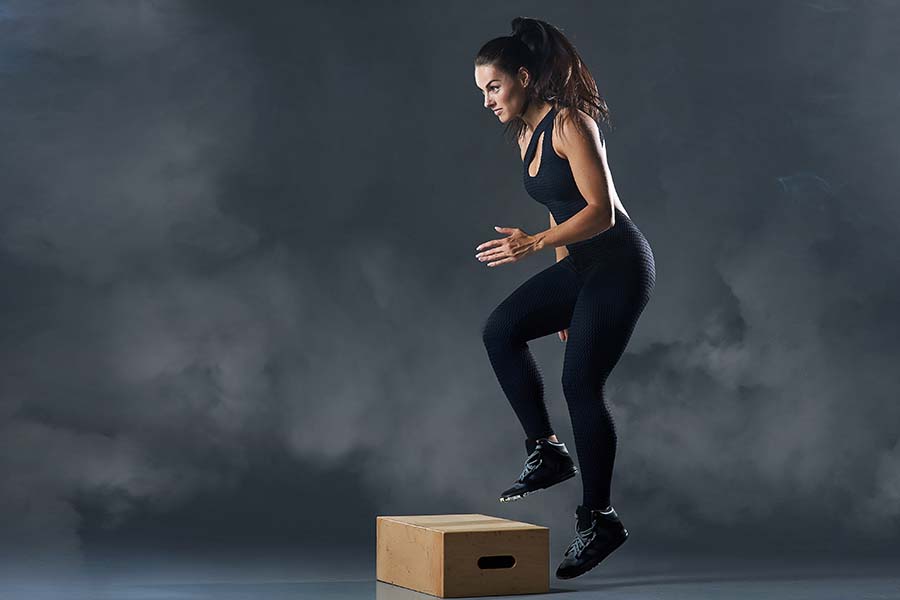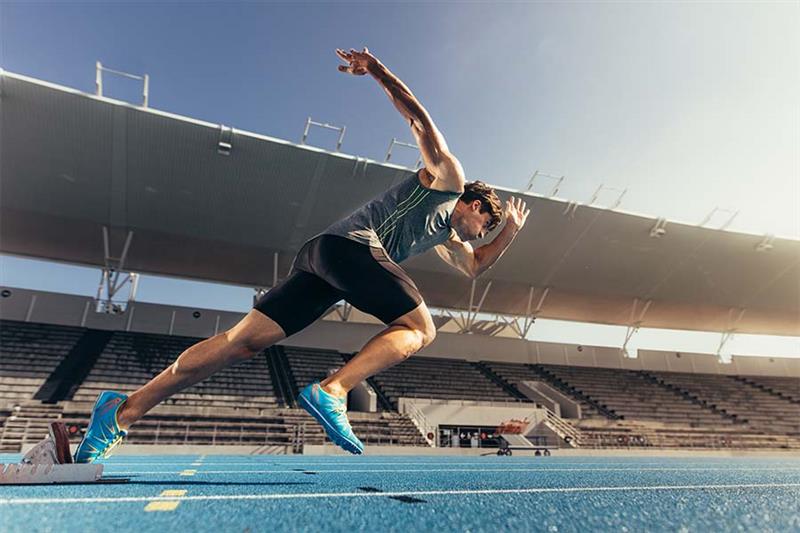Many athletes dedicate a lot of time to improving their speed but cannot make the desired gains. It can be frustrating and discouraging, which may lead athletes to abandon their efforts altogether.
Are you facing the same problem? Is it one of the reasons for your low performance? We know you have always been striving to be faster. After all, what good is brute force if you can't even catch your opponent?
Well, speed is the most crucial factor in many sports, whether lateral quickness or max speed. Either way, moving faster can give you a significant competitive advantage. And that's why athletes have always been looking for ways to improve their speed.
Also, most people think speed is the be-all and end-all for sports performance. However, they often fail to realize that acceleration is just as significant, if not more so.
Take, for example, a sprinter. It is not adequate for them to simply have a high top speed. They also need to be able to accelerate quickly to reach that top speed in the first place.
Similarly, a football player needs to be able to accelerate quickly to make a burst past their defender. In short, speed may be necessary, but it is essentially useless without acceleration.
Acceleration in sports is often determined by an athlete's ability to produce force against the ground. The faster an athlete can do this, the greater their acceleration will be.
However, acceleration is not just about speed. It is also about how quickly an athlete can change directions. It is where sport-specific acceleration comes in. Sport-specific acceleration is the ability to change directions quickly while still maintaining high speeds.
It is often the key to success in sports such as football, basketball, and hockey. To be successful in these sports, athletes need to be able to explode out of start-stops and make sudden changes in direction. Sport-specific acceleration training helps athletes develop these essential skills.
It is what we’ll be discussing in the article. We’ll tell you some amazing exercises that help improve sport-specific muscle acceleration and speed.
Related Article: Sprints for Fat Loss and Improved Performance
Exercises for Sport-Specific Muscle Acceleration
Many people think running sprints is the only way to get faster at sports. However, a variety of exercises can help you accelerate more quickly, and many are specific to the muscles used in particular sports.
For example, one exercise that can help you accelerate more quickly on the soccer field is to sprint while dragging a weighted sled behind you. This type of exercise helps in building strength and explosive power in your legs needed for quick starts and sharp direction changes.
Another exercise that can help accelerate baseball is starting from a crouched position and jumping forward as far as possible. It helps develop the powerful hip and thigh muscles to generate bat speed.
Whether you're a professional player or just trying to stay in shape, exercises that target sport-specific muscles can help you see results faster.
The following are some exercises specific to the muscles used in your chosen sport to help promote physical performance and running speeds.
Glute Bridge Overhead Reach

It is an exercise that primarily targets the muscles of the lower body, including the glutes and hamstrings (back of the upper leg). It also brings into play the muscles of the core, specifically the abdominals and lower back.
This exercise's benefits include improving hip mobility, strengthening the muscles around the hips and pelvis, and stabilizing the spine.
- Lie flat on the ground with feet flat and shoulder-width apart; legs bent to 90 degrees.
- Drive your heels into the ground, and lift your torso and upper legs into the air. Extend your hips until your thighs and torso are in line with each other - hold for two seconds
- Reach your right-hand overhead, toward the left foothold, for two seconds
- Reverse the motion, and lower your torso and upper legs back to the starting position
- Repeat on the opposite side
Wall Drills

Wall drills are a great way to improve your agility and footwork. By drilling against a wall, you can work on your explosiveness and quickness. It is especially beneficial if you play a sport that requires a lot of stop-and-start motion, such as basketball or football.
In addition, wall drills can help you develop better balance and muscle coordination. By constantly changing directions, you will force your body to adapt and become more efficient at moving in all directions.
- Stand staggered with your left foot in front of your right.
- Lean into your back foot and lift your front foot off the ground.
- Swing your front leg forward and up, and then quickly swing it backward and down.
- Keep your abdominal muscles engaged in helping you balance.
- Repeat the exercise 10 times, then switch legs.
High to Low Box Jumps

High to low box jumps are a plyometric exercise that can help improve your power, agility, and coordination. The movements involved in this exercise mimic those of everyday sports activities, such as jumping and changing direction quickly.
As a result, high to low box jumps can effectively promote physical performance in sports. This exercise can also help improve your bone density and reduce your risk of injury.
- Start by standing before a box or sturdy surface about knee height.
- Step onto the box with your dominant foot first, then follow with your other foot.
- Drive your hips and glutes upward, jumping off the box and landing on both feet.
- Make sure to complete the landing and absorb the impact through your entire foot, not just your toes.
- Repeat this movement until you've completed the desired number of reps.
Kettlebell Leg Drive

Kettlebell leg drive is an excellent exercise for those seeking a full-body workout. This move works the entire lower body, including the hips, glutes, hamstrings, and quads.
It engages your core and upper body, making it a great all-around exercise. The main benefit of kettlebell leg drive is that it promotes strength and power in the lower body.
- Hold two kettlebells in each hand or bring one near to your chest.
- Step one leg up the stairway or floor. Drive with your stepping foot and fully extend your leg. As you step, drive up the other knee.
- Reduce gradually to standing, then do it again.
Slide-Board Glute Bridge

It is a great exercise for toning and tightening your backside. Not only does it work your glutes, but it also strengthens your hamstrings and lower back. Plus, it's a great way to get a little heart-pumping cardio in as well.
- Lie flat on the ground with feet flat and shoulder-width apart; legs bent to 90 degrees.
- Drive your heels into the ground, then press your hips up towards the ceiling. Extend your hips until your thighs and torso align with each other.
- Hold for two seconds. Reverse your motion, and slowly lower yourself back to the initial position.
Goblet Toe Lunge

The goblet toe lunge provides several benefits for improving their overall fitness. Not only does it help tone and strengthen the legs, but it also helps to improve balance and coordination.
It is an excellent way to stretch the muscles in the hips and low back. As a result, it can help relieve pain and tension in these areas.
- Stand firm with feet hip-width apart and arms at your sides.
- Hold a goblet with both hands, your elbows, and your hands close to your chest.
- Step one foot forward and bend the knee, so the thigh is parallel to the floor. Keep the heel of that foot on the ground.
- Lower your body towards the floor, but do not touch it yet. Keep the back straight and core engaged.
- Lunge forward with your other leg, lowering your body towards the floor until your front thigh is parallel to the floor and your back knee is close to the floor. Make sure both knees are bent to 90 degrees.
- Pause for a moment, then press yourself back to the starting position. Repeat on the other side.
1/2 Kneel Two-Cone Drill

It is an effective way to improve your footwork and agility. By setting up two cones a short distance apart, you can create an obstacle course that rapidly forces you to change directions. Soccer players often use this drill, but it can benefit athletes in any sport.
Because the two-cone drill simulates gameplay movements, it helps improve your reaction time and coordination. In addition, this drill can also help increase your speed and stamina.
- Position cones 10 yards apart.
- Have your partner stand at one cone and you at the other.
- Sprint to the cone your partner is standing at, touch it, then sprint back to your original cone.
- Repeat this for the designated number of reps or time limit.
Single-Leg Olympic Lifts

The single-leg Olympic lift improves your balance, coordination and promotes strength. They also help promote explosive power and can be used to increase your speed and agility.
In addition, single-leg Olympic lifts are a great way to target specific muscle groups. You can add it to your weight lifting routine to see some significant improvements in muscle endurance.
- Begin by standing on one leg with the other elevated off the ground.
- Hold a barbell with your arm straight, and then lift the weight above your head.
- Keep your back straight and your core engaged as you lift the weight.
- Hold the position for a second before lowering the weight back to the initial position.
- Repeat the movements for the desired number of reps before switching legs.
Single-Arm Pushups

There are many benefits to doing single-arm pushups, not just for upper body optimal strength. It targets your core muscles to work harder to keep your body in alignment.
As a result, you'll get stronger muscles, arms and shoulders, and improve your posture and core optimal strength.
In addition, single-arm pushups are a great way to challenge yourself and continue progressing in your fitness journey.
- Get into a standard pushup position.
- Shift your weight to one arm and slowly lower yourself down.
- Keep your core engaged, and your glutes and hamstrings contracted to maintain stability.
- Pause at the bottom of the movement, then press back up to the starting position.
- Repeat on the other side.
Staggered Stance Cable Push-Pull

This move targets the quads, hamstrings, and glutes, making it an ideal choice for leg day. But that's not all this exercise has to offer. The staggered stance also helps to improve balance and stability, while the cable adds resistance which accelerates muscle strength.
- Stand with staggered stances, left foot in front of right.
- Hold a cable at chest level with palms facing each other.
- Push the cable forward and pull it back to starting position.
Sports-Specific Nutrition and Supplementation
Good nutrition is a must for all athletes, but it becomes even more crucial when improving speed and acceleration. Many people think that just because they're athletes, they can eat whatever they want and not worry about their diets.
But the truth is, what you eat directly impacts your performance. You must ensure you're getting the proper nutrients to be at your best. That's where sport-specific nutrition comes in.
Depending on your sport, you must choose intelligent nutritional solutions and pick certain nutrients to help you perform better. For example, if you're a runner, you might want to focus on getting more iron since that helps improve oxygen transport and boost energy production.
Or, if you're a swimmer, you might want to up your intake of omega-3 fatty acids, which can help curb inflammation and improve joint health. No matter what sport you're involved in, a specific nutrition plan can help you perform at your best.
Related Article: Gain Lean Muscles: Workout, Nutrition Plan & More
Grains
When it comes to selecting grains, there is no healthy shortcut, and whole grains should be your go-to. Why? They simply offer more nutrients than refined or white grain products.
Plus, they're rich in carbohydrates, essential for fueling high-intensity activity and aiding in recovery afterwards.
Depending on your physical activity level, you should aim to consume one to two fists worth of whole grains at each meal, especially before exercise.
So the next time you plan your meals, remember to prioritize whole grains for their significant vitamin, mineral, and fiber content. Your body will thank you!
Proteins
Proteins are essential nutrients that play a necessary role in several critical functions in the body, such as cell structure, muscle maintenance, and chemical reactions.
Amino acids are the building blocks of proteins, and there are twenty different amino acids that the body needs to function properly. Of these twenty amino acids, nine are considered "essential" because the body cannot produce them on its own.
As a result, it's important to include complete protein sources in your diet to ensure that your body has all the amino acids it needs.
Animal proteins are complete sources of all essential amino acids, but certain combinations of plant-based proteins can also provide adequate amounts.
When choosing protein sources, it's essential to prioritize lean animal proteins such as poultry and fish, which should make up about a quarter of your plate and be about a palm in size as per modern nutritional practices.
By including complete protein sources in your diet, you can help support various important functions in your body.
Fruits and Vegetables
A well-rounded diet is essential for maintaining good health, and fruits and vegetables should be a significant part of every meal. These food groups mainly provide micronutrients, including vitamins, minerals, fiber, water, and antioxidants, which all work together to support our bodies in multiple ways.
For instance, they boost energy, help with hydration and digestion, and aid recovery from injuries.
It's important to note that serving sizes for fruits and vegetables can vary depending on the type of food. A serving size is about one fist for starchy vegetables like corn, peas, and potatoes.
For other vegetables, the serving size is two fists. When putting together a plate of food, aim for half of the plate to be fruits and vegetables combined. This way, you'll be sure to get the nutrients your body needs at every meal.
Dairy
Athletes must ensure they consume enough dairy or dairy alternatives to get the nutrients their bodies need. Dairy provides protein, calcium, potassium, and carbohydrates, all of which are important for athletes.
Protein is necessary for muscle contraction and recovery, calcium is necessary for bone health, potassium is necessary to boost energy production, and carbohydrates are necessary for energy production.
Athletes should consume 2-3 cups of low-fat dairy or dairy alternatives daily.
Supplementation
In addition to eating right, athletes must also pay attention to supplementation. Just like with nutrition, a dietary supplement can help with specific sports.
Athletes often use creatine to help increase muscle mass and power output. DMoose creatine powder is a herbal ingredients renowned and is made with 100% organic ingredients and low carbs and calories. It helps increase muscle recovery, controls blood sugar, and fights fatigue.
Protein powders such as DMoose whey protein contain whey protein isolate and concentrate. These two premium proteins may be used for energy boosting and recovery. This mighty formula supplement improves exercise performance, muscular mass, and workout recovery.
Vitamin D is a strength boosting supplement that is excellent for athletic performance besides creatine and whey protein. This essential nutrient helps the body to absorb calcium, promoting strong bones and muscles better.
Vitamin D also aids in immune system function, making it easier for the body to recover from strenuous activity.
Ashwagandha is an adaptogenic herb that has many benefits for athletes. It can help improve endurance gains, speed recovery time, and build muscle mass.
Additionally, ashwagandha can help support circulatory system health and reduce stress and anxiety, which can interfere with athletic performance. For these reasons, ashwagandha is a valuable supplement for athletes of all levels.
Following a sport-specific nutrition plan and supplementing with a balanced combination of ingredients can give you a competitive edge.
Related Article: Whey Protein: Health Benefits, Side Effects and Precautions
The Bottom Line
You can do the exercises mentioned in this article to improve your sport-specific muscle acceleration. Remember, it’s not just about running fast; you need to be able to accelerate quickly and powerfully too!
If you want help incorporating these exercises into your training routine, feel free to reach out. We would be delighted to assist you in achieving your performance goals.








